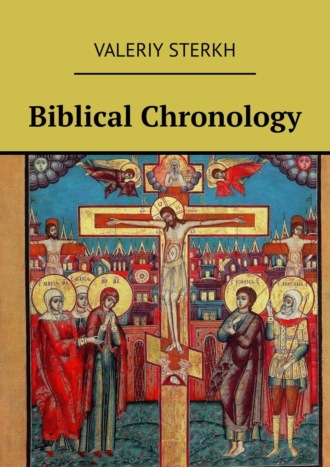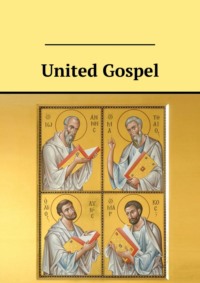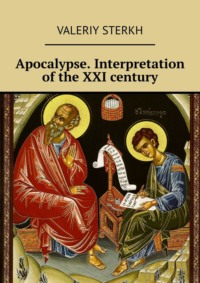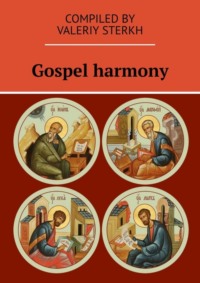
Полная версия
Biblical Chronology
“And he [Jehoiakim] reigned 11 years in Jerusalem” (2 Kings 23:36).
“So Jehoiakim slept with his fathers: and Jehoiachin his son reigned in his stead” (2 Kings 24:6).
“And he [Jehoiachin] reigned in Jerusalem 3 months” (2 Kings 24:8).
“And he [Nebuchadnezzar] carried away Jehoiachin to Babylon, and the king’s mother, and the king’s wives, and his officers, and the mighty of the land, those carried he into captivity from Jerusalem to Babylon” (2 Kings 24:15).
“And the king of Babylon made Mattaniah his [Jehoiachin] father’s brother king in his stead, and changed his name to Zedekiah” (2 Kings 24:17).
4943+11=4954
4965 (-585). Judea is enslaved by Babylon
“And he [Zedekiah] reigned 11 years in Jerusalem” (2 Kings 24:18).
“So they took the king, and brought him up to the king of Babylon to Riblah; and they gave judgment upon him. And they slew the sons of Zedekiah before his eyes, and put out the eyes of Zedekiah, and bound him with fetters of brass, and carried him to Babylon. And in the fifth month, on the seventh day of the month, which is the nineteenth year of king Nebuchadnezzar king of Babylon, came Nebuzaradan, captain of the guard, a servant of the king of Babylon, unto Jerusalem: And he burnt the house of the LORD, and the king’s house, and all the houses of Jerusalem, and every great man’s house burnt he with fire. And all the army of the Chaldees, that were with the captain of the guard, brake down the walls of Jerusalem round about. Now the rest of the people that were left in the city, and the fugitives that fell away to the king of Babylon, with the remnant of the multitude, did Nebuzaradan the captain of the guard carry away” (2 Kings 25:6—11).
Modern science dates the conquest of Jerusalem by the Babylonian king Nebuchadnezzar II (c. 634 – 562 BNE) to 586 BNE.
4954+11=4965
5012 (-538). The conquest of Babylon by Cyrus II, the end of the Babylonian captivity of the Jews
“And they burnt the house of God, and brake down the wall of Jerusalem, and burnt all the palaces thereof with fire, and destroyed all the goodly vessels thereof. And them that had escaped from the sword carried he away to Babylon; where they were servants to him and his sons until the reign of the kingdom of Persia: To fulfil the word of the LORD by the mouth of Jeremiah, until the land had enjoyed her sabbaths: for as long as she lay desolate she kept sabbath, to fulfil 70 years” (2 Chron 36:19—21; compare Jer 25:11—12; Jer 29:10; Dan 9:2; Zech 1:12; Zech 7:4—5).
Modern science dates the conquest of Babylon by the Persian king Cyrus II (c. 593 – 530 BNE) to 539 BNE. As you may have noticed, the beginning of the seventy-year devastation of Judah falls on the date of the battle of Megiddo, 608 BNE. Three major captivities were experienced by the Jews in this period. The first was the exile inflicted at the hands of the Egyptian pharaoh Necho II in 608 BNE. The second one happened in 597 BNE, and the third one was in 586 BNE. The last two times they were captured by the Babylonian king Nebuchadnezzar II. Obviously, the 70-year-long period of the devastation of Judah is divided up into 11 years in Egypt and 59 years in Babylon.
4965+ (586—539) =5012
It is also important to note that 5550 years between the foundation of the world and the start of the new era is an approximate number. Taking into account the number of time intervals which make up the whole duration, as well as their number rounded to the accuracy of one year, the resulting error can roughly be estimated as plus or minus 50 years.
Modern-day scientists will, probably, disagree with dating the age the Earth as several thousand years. They will, most likely, cite scientific arguments in favor of the much older Solar system and Universe. It would be worth discussing this question separately, but it would probably require another book. At this time, let us limit ourselves to the information that we have from the Bible.
Section 3. Versions of the Gospel chronology
Christian sources on the life of Jesus Christ
The main sources of information on the life of Jesus Christ are the canonical Gospels written by the apostles Matthew, Mark, Luke and John.
The Gospel of Matthew was written about the third quarter of the 1st century. Tradition holds that it was written by Levi Matthew, the son of Alphaeus, one of the Twelve (see Mt 9:9; Mk 2:14; Lk 5:27). Originally it was written in the old Hebrew, but later it was translated into Greek and became widely accepted.
“So, Matthew wrote the Gospel for the Jews in their own language, while Peter and Paul were preaching in Rome and founded the Church” (Irenaeus of Lyons. Against Heresies, 3,1,1; compare Eusebius of Caesarea. Church History, 5,8).
“Initially Matthew preached the Gospel to the Jews; but then he took it to other nations, though it was written in his own tongue. When summoned to go elsewhere, he left them with his Scripture” (Eusebius of Caesarea. Church History, 3,24,6).
“Matthew the Apostle, who was also called Levi, used to be a tax-collector; he complied the Gospel of Jesus Christ for the sake of spiritual cleansing of believers. At first, it was published in Judea in Hebrew, but later someone translated it into Greek [compare Eusebius of Caesarea, Church History, 3,39,16]. The Hebrew version survived to the present day [around the beginning of the 5th century] in the Library of Caesarea [Caesarea of Palestine], so arduously created and maintained by Pamphilus [of Caesarea]. I also had the opportunity to get the book described for me by the Nazarene from the Syrian town of Berea who had been using it. It must be noted that this Gospel-writer, in quoting the Old Testament testimonies, whether himself or on behalf of our Lord and Savior, always follows the Hebrew text of the Covenant, not the authority of the translators of the Septuagint. Therefore, there are the following two versions: ‘Out of Egypt I have called my son’ [Mt 2:15; Hos 11:1] and: ‘He will be called a Nazorean’ [Mt 2:23; Is 11:1
The Gospel of Mark was written around the middle of the 1st century. According to the tradition, it was written by John Mark (see Act 12:12), the nephew of Barnabas (see Col 4:10), who was one of the seventy apostles and a co-worker of Peter (see 1 Pet 5:13). It is regarded as the earliest of the four Gospels. It is the shortest of them all, and it was used as a source for writing the Gospels of Matthew and Luke.
“These are the words of the presbyter [Papias of Hierapolis]: ‘Mark was the interpreter of Peter; he accurately recorded everything that the Lord had said and done, but not in order, for he himself did not hear the Lord speak, neither did he walk with Him. Later he accompanied Peter who taught as he saw fit based on the circumstances, and did not necessarily relate the words of Christ in order. In recording everything the way he remembered it, Mark did not err against the truth. His only concern was not to miss or misrepresent anything.’ That is what Papias said concerning Mark” (Eusebius of Caesarea. Church History, 3,39,15—16).
“Peter and Paul preached in Rome and founded a church there. After their departure, Mark, Peter’s disciple and interpreter, passed down to us in writing everything that Peter had taught” (Irenaeus of Lyons. Against Heresies, 3,1,1; compare Eusebius of Caesarea. Church History, 5,8).
“Mark, the disciple and the interpreter of Peter, wrote a short Gospel at the request of the fellowship in Rome, having recorded everything that he had heard from Peter. Clement [of Alexandria] in the sixth book of his ‘Brief Explanations’, as well as Papias, the bishop of Hierapolis, both testify that Peter approved of this work and declared that this Gospel should be read in all the churches. Peter also mentions Mark in his first epistle, metaphorically calling Rome Babylon: ‘The church that is at Babylon, elected together with you, saluteth you; and so doth Marcus my son’ [1 Pet 5:13]. Availing himself of the Gospel that he himself had compiled, Mark departed to Egypt, and, preaching Christianity in Alexandria, founded a church there, which became famous through its sound teaching and godliness, and was known for instructing all its adepts to follow the example of Christ. The highly-educated Jew by the name of Philo, witnessing the first church of Alexandria which was still Jewish by status, wrote a book about their way of life, confirming, according to Luke, that they had much in common with Jerusalem. Mark died in the eighth year of Nero’s reign [61/62 NE] and was buried in Alexandria. He was replaced by Annian” (Jerome of Stridon. On Famous Men, 8).
The Gospel of Luke was written around the third quarter of the 1st century. According to the tradition, it was written by Luke, the doctor, one of the Seventy and a co-laborer of Paul (see Col 4:14; Phm 1:24; 2 Tim 4:10).
“So, Luke, the co-laborer of Paul, wrote down in the form a book the Gospel which he preached” (Irenaeus of Lyons. Against Heresies, 3,1,1; compare Eusebius of Caesarea. Church History, 5,8).
“As one can gather from his writings, Luke, the doctor from Antioch, was very knowledgeable in the Greek language. The author of the Gospel and Paul’s follower, he accompanied the apostle in all his journeys. Here is what Paul said of him: “And we have sent with him the brother, whose praise is in the gospel throughout all the churches (Corinthians) [2 Cor 8:18]; “Luke, the beloved physician, and Demas greet you” (Colossians) [Col 4:14], “Only Luke is with me” (Timothy) [2 Tim 4:10]. The other excellent work written by Luke, “Acts of the Apostles”, covers events during Paul’s second year in Rome, which was the fourth year of Nero’s reign [57/58 NE]. On this basis we conclude that this book was written in this city… Some believe that when Paul says in his epistle: “according to my gospel, [Rom 2:16], he refers to the book of Luke [the Greek for Gospel is “Good News)], and that Luke knew the stories of the Gospel not only from Paul who didn’t see the Lord in the flesh, but also from other apostles. He mentions it in the beginning of his work: “…Even as they delivered them unto us, which from the beginning were eyewitnesses, and ministers of the word.” [Lk 1:2]. So, he wrote the Gospel on the basis of what he had heard from others, while “Acts of the Apostles” was written out of his own experience” (Jerome of Stridon. On Famous Men, 7).
The Gospel of John was written by the end of the 1st century. Tradition holds that it was compiled by John the Theologian, the son of Zebedee (see Mt 10:2; Mk 3:17; Lk 6:14; Jn 21:2, 24).
“Then, John, the disciple of Jesus who lay on His bosom [Jn 13:23], also published his Gospel during his time in Ephesus in Asia” (Irenaeus of Lyons. Against Heresies, 3,1,1; compare Eusebius of Caesarea. Church History, 5,8).
“John, the apostle, the one especially loved by Jesus [Jn 21:20, 24], the son of Zebedee and the brother of Jacob who was beheaded by Herod after the sufferings of the Lord, last of all wrote his Gospel at the request of some bishops in Asia who contended against Cerinthus and other heretics, especially the teachings of Ebionites who taught that Christ didn’t exist before Mary. So, John was asked to speak in defense of the doctrine of Divine Birth. There was yet another reason: having read the works of Matthew, Mark, and Luke, John approved of their narratives and confirmed that they contained the truth, noting that these narratives only describe was happened during the one year after John [the Baptist] was put in prison and executed. So, he himself wrote about a period preceding John’s imprisonment, and it can be a revelation for those who diligently read the works of the Gospel-writers. In addition, this consideration removes the contradictions that seemed to exist between the text of John and others… On the fourteenth year after Nero [82 NE] Domitian began the second persecution against Christians. John was exiled to the island of Patmos and wrote there the Apocalypse, which was later commented on by Justin Martyr and Irenaeus. But after Domitian’s death [96 NE] and the abolition of his cruel decrees, John returned to the city of Ephesus and, remaining there until the arrival of the emperor Trajan, contributed in every way to the planting of churches throughout Asia. Died of old age in the 68th year after the Passion of the Lord and was buried near Ephesus” (Jerome of Stridon. On Famous Men, 7; compare Eusebius of Caesarea. Church History, 3,24,7—14).
So, out of the four canonical Gospels, two were written by the closest disciples of Jesus Christ, the apostles John and Matthew, who were eyewitnesses of the described events. The other two were written by Mark and Luke, the disciples of Jesus, who belonged to the Seventy and were called at a later time (see Lk 10:1—2). Nevertheless, they had been in close contact with the original Twelve. All of them related in their narratives not only what they could remember themselves, but also the accounts of those who lived near to the time of Jesus. So, the Gospel narratives are the firsthand and secondhand sources, which, by their very nature, are more accurate and have more credibility compared to any other sources of information.
In later chapter we will examine the exact information provided in the four canonical Gospels with regard to chronology.
In addition to the canonical Gospels, there is also a number of Apocryphal Gospels. They were not included in the Canon either because they contain a pious forgery or because of some heretical content. That is why it would be highly inadvisable to use them for the purposes of recreating biblical chronology.
Non-Christian sources on the life of Jesus Christ
Among the whole corpus of early non-Christian writings which shed light on the life of Jesus Christ, the following are particularly noteworthy.
Pliny the Younger (c. 61 – c. 113 NE), a Roman politician and writer, a lawyer. In a letter to the Emperor Trajan (reigned in 98 – 117 NE) he says:
“I consider it my sacred duty to seek your advice, sire, to find an answer to those questions that arouse my bewilderment. I’ve never witnessed trials against Christians. Therefore, I do not know what they are usually interrogated on and for what and to what extent they are punished. For I was in a great difficulty as to whether I should recognize the differences in their ages, or not at all distinguish minors from mature adults, whether I should grant pardon for repentance (or maybe renunciation of Christianity would not do any good to someone who was once a Christian), whether to execute them for the very name they bear [nomen ipsum] in the absence of any other crimes, or for the crimes [flagitia] having some connection with the name. Meanwhile, I acted in the following manner with those who, as I was informed, were Christians. I interrogated them on whether they were Christians and, when they confessed, I pressed my question the second and third time while threatening them with execution. Those who persisted I ordered to be executed [ducijussi]. I didn’t doubt that, regardless of the nature of wrongs they confessed, their stubbornness and impenitence alone deserved punishment. However, apart from those executed, there were others who were out of their minds as well. But because they were Roman citizens, I ordered that they be set apart to be sent to the capital. However, we had more and more complications as we proceeded. I received an anonymous report containing a list of Christians, but among them there were quite a few of those who denied that they were Christians and claimed they had never belonged to that group. When they, together with me, called upon the gods and worshiped your image which I had ordered to bring along with the statues of the gods, and when they cursed the name of Christ (they say, true Christians cannot be forced to do any of these three acts), I deemed it possible to release them. Others, whose names were on the list, confessed that they had been Christians at one time but left that fellowship, some three year ago, some earlier, and some even twenty years ago. All of them worshiped your image and the statues of the gods, having cursed the name of Christ. According to their own words, their whole crime consisted in that they gathered together early in the morning on certain days and sang hymns to Christ as God, and that in the name of religion [sacramento] they had bound themselves not to do any crimes, but to refrain from stealing, robbery, adultery, to keep promises and pay off debts, and that after their gatherings they got together again to take food, which was, incidentally, regular and innocent. And even this they stopped doing after I banned the hetaeria on your authority. Nevertheless, I judged it necessary to subject to torture the two slaves, who were called deaconesses [ministrae], in order to find out what is right and just there. But I found nothing except utter superstition of a gross kind. Therefore, postponing further proceedings, I appeal to you for advice” (Letter 10,96).
In terms of chronology, the above letter, testifies only to the relatively wide spread of Christianity by the beginning of the second century.
Gaius Suetonius Tranquill (c. 70 – c. 126 NE), Roman writer, historian, encyclopedist, and personal secretary of Emperor Hadrian. In his work “The Lives of the Twelve Caesars” [De vita Caesarum], he records the deeds of the Emperor Claudius (reigned in 41 – 54 NE):
“He [Claudius] expelled from Rome the Jews who were constantly stirred by Chresto” (Ibid., 5,25,4).
Some skeptical scholars, who see here the name of Chrest, are not inclined to associate it with Jesus. On the other hand, there’s nothing here that prevents us from assuming that this is a distorted name of Christus or Χριστός. Moreover, this is exactly what Tertullian points out: “The designation ‘Christian’, as follows from the etymology of the word, derives from the word ‘anointment’. And the name Chrestian, incorrectly pronounced by you [Romans] (because you do not even know exactly what we are called), means ‘pleasantness’ or ‘goodness’” (Apologeticum, 3,5). Lactantius makes a similar remark: “However, it is necessary to explain the meaning of this name [Christ] because some ignorant people, who would call him Chrest, make a mistake by mixing up the two sounds” (Divine Institutes, 4,7,5). Also, the Book of Acts says that when Paul came to Corinth, he found there the exiled Jews, “because that Claudius had commanded all Jews to depart from Rome” (Act 18:2). But what else, other than the spreading of the teaching of Jesus Christ, could cause the Roman Jews to be “constantly stirred”?
The stubbornness of skeptics in this matter is not so arbitrary as it is pointless, because Suetonius speaks more precisely in another place of “The Lives of the Twelve Caesars”, Suetonius, speaking of the deeds of the Emperor Nero (reigned in 54 – 68 NE): « [Nero] punished Christians [Christiani], the adherents of a new and pernicious superstition” (Ibid., 6,16,2). The reasons behind this persecution were explained by Tacitus, as will be mentioned later.
Speaking of chronology, Suetonius testifies to the wide spread of Christianity in the middle of the first century.
Cornelius Tacitus (c. 55 – c. 120 NE), the Roman writer, historian, forensic orator, senator. In his “Annales” he writes:
“And Nero, wishing to overcome the rumors [about his orders to set Rome on fire], found the scapegoats and gave over to the most excruciating tortures those who through their abominations had incurred general hatred of the populace and whom the crowd called Christians. This Christ, from whom this name is derived, was executed by the procurator Pontius Pilate under Tiberius. For a time this malicious superstition was suppressed but then broke out again, and not only in Judea where this blight originated, but also in Rome, where every abomination and every shameful thing in the world is gathered and where it finds ready adepts. So, at first, those who openly recognized themselves as belonging to this sect were seized, and then, using the information they provided, a great number of others were denounced, not so much as villainous arsonists but as haters of the human race in general. Their executions were accompanied by humiliations and insults, for they were clothed in the skins of wild animals so as to be torn apart by dogs; they were crucified on crosses, and, being sentenced to death by burning, set on fire at nightfall for illumination. Nero provided his gardens for this show. He also organized a performance in the circus where he sat among the crowds, clothed as a charioteer, or rode in a chariot as a participant in a contest. And although those Christians were guilty and deserved the severest of punishments, all these cruelties aroused compassion for them, for it seemed that they were being exterminated not for the sake of the common good, but simply because of Nero’s bloodthirstiness” (Ibid., 15,44).
Tacitus specifically mentions the execution of Jesus Christ as taking place at the time of the emperor Tiberius in Rome and Pontius Pilate in Judea. But this does not give us any more information apart from what we already know from the Gospels.
Josephus Flavius (c. 37 – c. 100) was the Jewish commander, writer, historian who served at the Roman court. He writes in his work “Judean Antiquities”:
“Having learned of the death of [Porcius] Festus, the emperor sent [Lucceius] Albinus as his procurator in Judea. About the same time, the king [Agrippa] stripped Joseph [Cavius] of his high-priesthood and appointed Ananus, the son of Ananus, as his successor. The latter, Ananus the Senior, was a very happy man: he had five sons who all became high priests after him, and he himself had occupied this honorable position for a very long time. None of our high priests had such a happy lot in life. Anan the Junior, of whose appointment we just spoke, was a harsh and impetuous man. He belonged to the party of the Sadducees, which, as we have already mentioned, was known in courts for their immoderate cruelty. Being a ruthless man, Anus considered the death of Festus and Albinus’s temporary absence to be a perfect time to satisfy his cruelty. So, calling together the Sanhedrin, he had them interrogate James [Jacob], the brother of Jesus, called Christ, as well as several others. They were accused of violating the laws and sentenced to death by stoning” (Ibid., 20,9,1).
Porcius Festus was a Roman governor in Judea between the years 59—62 NE at the time of Agrippa II, the tetrarch. Agrippa reigned between 48 – 93 NE, and his reign is associated with the trial of the apostle Paul in Caesarea (see Act 25—26). Anan the Senior is mentioned in the Gospels as High Priest Annas, Joseph Caiaphas’s father-in-law (see Lk 3:2; Jn 18:13, 24). The high-priesthood of Anan the Senior falls on years 6—15 NE, and the high-priesthood of Caiaphas between 18—37 NE. The sons of Anan (Annas) also became High Priests: Eleazar was the high priest in the years 16—17 NE (Judean Antiquities, 18,2,2), Jonathan in 37 NE (Ibid., 18,4,3; 18,5,3; 19,6,4), Theophilus in the years 37—41 NE (Ibid., 18,5,3; 19,6,2). [Could he be that very “Honorable [most excellent] Theophilus” to whom Luke addressed two of his books and who subsequently converted to Christianity? See Lk 1:3; Act 1:1], Matthias in 43 NE (Ibid., 19,6,4; 19,8,1), Anan the Junior in 63 NE (Ibid., 20,9,1). So, according to Josephus, James [Jacob], the stepbrother of Jesus, was executed in 63 NE. James, the brother of Jesus, is mentioned in the New Testament (see Mt 13:55; Mk 6:3; Act 12:17; 15:13; 21:18; Gal 1:18—19; 2:9). Also, Eusebius of Caesarea quotes Hegesippus, the second-century Christian writer, who says that James [Jacob] was thrown down from the roof of the Jerusalem temple and then stoned to death (see Church History, 2,23).
Elsewhere, Josephus writes:
“There lived around this time a wise man, Jesus <, if such a designation can be applied to him>. He was performing amazing deeds and became the Mentor for those who readily accepted the truth. He attracted many Jews and Greeks to himself.






